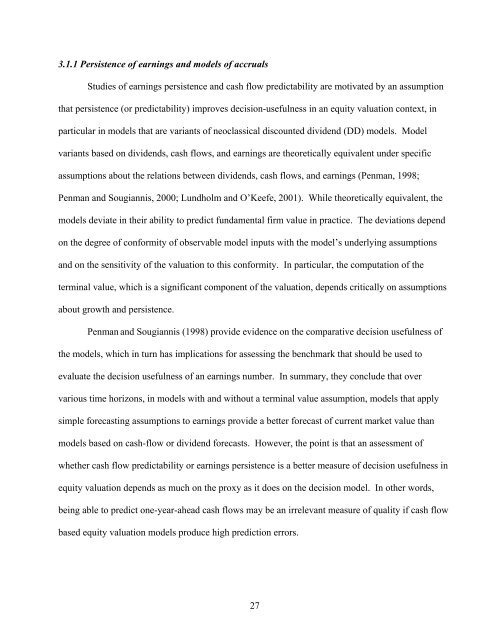Understanding earnings quality - MIT Sloan School of Management
Understanding earnings quality - MIT Sloan School of Management
Understanding earnings quality - MIT Sloan School of Management
Create successful ePaper yourself
Turn your PDF publications into a flip-book with our unique Google optimized e-Paper software.
3.1.1 Persistence <strong>of</strong> <strong>earnings</strong> and models <strong>of</strong> accruals<br />
Studies <strong>of</strong> <strong>earnings</strong> persistence and cash flow predictability are motivated by an assumption<br />
that persistence (or predictability) improves decision-usefulness in an equity valuation context, in<br />
particular in models that are variants <strong>of</strong> neoclassical discounted dividend (DD) models. Model<br />
variants based on dividends, cash flows, and <strong>earnings</strong> are theoretically equivalent under specific<br />
assumptions about the relations between dividends, cash flows, and <strong>earnings</strong> (Penman, 1998;<br />
Penman and Sougiannis, 2000; Lundholm and O’Keefe, 2001). While theoretically equivalent, the<br />
models deviate in their ability to predict fundamental firm value in practice. The deviations depend<br />
on the degree <strong>of</strong> conformity <strong>of</strong> observable model inputs with the model’s underlying assumptions<br />
and on the sensitivity <strong>of</strong> the valuation to this conformity. In particular, the computation <strong>of</strong> the<br />
terminal value, which is a significant component <strong>of</strong> the valuation, depends critically on assumptions<br />
about growth and persistence.<br />
Penman and Sougiannis (1998) provide evidence on the comparative decision usefulness <strong>of</strong><br />
the models, which in turn has implications for assessing the benchmark that should be used to<br />
evaluate the decision usefulness <strong>of</strong> an <strong>earnings</strong> number. In summary, they conclude that over<br />
various time horizons, in models with and without a terminal value assumption, models that apply<br />
simple forecasting assumptions to <strong>earnings</strong> provide a better forecast <strong>of</strong> current market value than<br />
models based on cash-flow or dividend forecasts. However, the point is that an assessment <strong>of</strong><br />
whether cash flow predictability or <strong>earnings</strong> persistence is a better measure <strong>of</strong> decision usefulness in<br />
equity valuation depends as much on the proxy as it does on the decision model. In other words,<br />
being able to predict one-year-ahead cash flows may be an irrelevant measure <strong>of</strong> <strong>quality</strong> if cash flow<br />
based equity valuation models produce high prediction errors.<br />
27
















